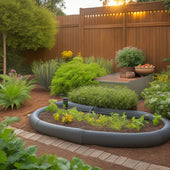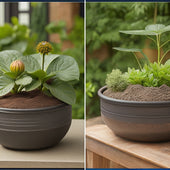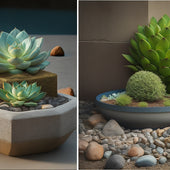
5 Best Ways to Regulate Rooftop Garden Temperature
Share
To regulate your rooftop garden's temperature, you'll want to take into account five effective methods. Shading devices like awnings and screens can block direct sunlight, while insulation and radiant barriers can reduce heat gain by up to 97%. Evaporative cooling methods, such as wetted surfaces or cooling towers, can also absorb heat energy. Misting and fogging systems create a cooling microclimate, and thermal mass elements with night cooling strategies can moderate temperature extremes. By combining these methods, you'll be able to create an ideal environment for your plants, and exploring each technique in more depth will help you fine-tune your rooftop garden's climate.
Key Takeaways
• Awnings and screens can block direct sunlight, reducing rooftop garden temperatures and creating a favorable environment for plants.
• Insulation and radiant barriers can lower temperatures by up to 97% during summer months, making them crucial in warm climates.
• Evaporative cooling methods, such as wetted surfaces or pads, can absorb heat energy and regulate temperatures effectively in dry climates.
• Misting and fogging systems can distribute water droplets into the air, cooling the environment and increasing humidity for plants.
• Thermal mass elements, combined with night cooling strategies, can moderate temperature extremes and create a stable environment for rooftop garden plants.
Shading With Awnings and Screens
To effectively regulate rooftop garden temperatures, you can employ shading devices like awnings and screens to block direct sunlight during peak hours.
Awnings, typically made from materials like fabric, metal, or wood, can be installed above windows or along the rooftop's edge to provide shade. You can choose from various awnings materials, such as waterproof canvas or retractable aluminum frames, depending on your specific needs.
Screens, on the other hand, can be fixed or retractable and come in different types like solar screens, shade screens, or insect screens. These screens can be installed on walls, windows, or even the roof itself to filter the sun's rays.
By strategically placing awnings and screens, you can reduce the amount of direct sunlight that reaches your rooftop garden, thereby lowering temperatures and creating a more favorable environment for your plants.
Insulation and Radiant Barriers
You can further regulate rooftop garden temperatures by incorporating insulation and radiant barriers into your design, which can reduce heat gain by up to 97% during summer months. These solutions are particularly effective in warm climates where high temperatures can be detrimental to plant growth.
Insulation materials such as foam board, fiberglass, or reflective insulation can be installed beneath the growing medium or on the rooftop itself to prevent heat transfer. Radiant barriers, on the other hand, work by reflecting radiant heat rather than absorbing it, making them an excellent choice for rooftop gardens.
The radiant barrier effectiveness can be enhanced by installing them in conjunction with insulation materials. When selecting insulation materials, consider factors such as R-value, durability, and moisture resistance to guarantee peak performance.
Evaporative Cooling Methods
Evaporative cooling methods, which exploit the principle that water evaporation absorbs heat energy, offer an effective and energy-efficient means of regulating rooftop garden temperatures.
By incorporating evaporative cooling methods, you can create a microclimate that's ideal for your plants. One way to do this is by using wetted surfaces or pads that cool the air as it passes through them. This method is particularly effective in dry climates. Another approach is to use evaporative cooling towers, which can be installed on your rooftop garden. These towers use water to cool the air, providing a natural and energy-efficient way to regulate temperatures.
When using evaporative cooling methods, it's crucial to take plant selection and water conservation into account. Choose plants that are adapted to your local climate and can thrive in the conditions created by the evaporative cooling system.
Additionally, make sure that your system is designed to conserve water, as excessive water usage can negate the benefits of evaporative cooling. By implementing an effective evaporative cooling method, you can maintain a comfortable temperature in your rooftop garden while minimizing your environmental impact.
Misting and Fogging Systems
One effective way to regulate rooftop garden temperatures is by utilizing misting and fogging systems, which finely distribute water droplets into the air to cool the surrounding environment. These systems are particularly useful during hot summer days when the temperature can soar.
By installing misting nozzles or fogging units, you can create a microclimate that's ideal for your plants. The misting techniques used in these systems guarantee that water is evenly distributed, avoiding puddles and runoff. This not only cools the air but also increases the humidity, creating a more comfortable environment for your plants.
To enhance fogging efficiency, you'll want to take into account factors like droplet size, pressure, and flow rate. By fine-tuning these variables, you can achieve the perfect balance of cooling and humidity.
Additionally, you can automate your misting and fogging systems to confirm they're operating at peak levels, even when you're not around. With the right setup, you can enjoy a rooftop garden that's always at the perfect temperature.
Thermal Mass and Night Cooling
While misting and fogging systems provide relief from scorching temperatures, thermal mass and night cooling strategies can be employed to regulate rooftop garden temperatures during the cooler hours, effectively moderating the diurnal temperature fluctuations.
By incorporating thermal mass elements, such as concrete or brick, into your rooftop garden design, you can harness their high thermal conductivity to absorb and release heat. This helps to regulate temperature extremes, keeping your garden cooler during the day and warmer at night.
To maximize the benefits of thermal mass, consider placing these elements in areas that receive direct sunlight or using them as a base for planters.
Additionally, you can employ night cooling strategies by using materials with high heat retention, such as stone or ceramic, to release stored heat at night, reducing the temperature.
Frequently Asked Questions
Can Rooftop Gardens Be Temperature-Regulated in Extreme Climates?
You can successfully regulate rooftop garden temperatures in extreme climates by implementing climate adaptation strategies and thermal insulation techniques, such as using reflective materials, shading devices, and advanced irrigation systems to maintain ideal growing conditions.
Are Rooftop Gardens Suitable for All Types of Buildings?
'When you're pushing the envelope, you'll find that rooftop gardens aren't a one-size-fits-all solution; you'll need to take into account the building type and structural considerations, as some structures may not be able to support the weight and stress.'
Do Rooftop Gardens Increase the Risk of Water Damage?
You need to guarantee proper water management in your rooftop garden, as poor drainage systems can increase the risk of water damage; installing a reliable drainage system and waterproofing membranes mitigates this risk, giving you control.
Can Rooftop Gardens Be Used for Food Production?
You can successfully use rooftop gardens for food production, leveraging urban agriculture and sustainable design principles to create thriving ecosystems that provide fresh produce while minimizing environmental impact and maximizing spatial efficiency.
Are Rooftop Gardens a Fire Hazard?
Like Icarus soaring too close to the sun, you're wise to contemplate the fire hazard risks of rooftop gardens, particularly with heat retention concerns, so prioritize fire safety measures to prevent a blaze from igniting your green oasis.
Related Posts
-

Irrigation Solutions for Raised Bed Planters Made Easy
You can optimize your raised bed planters' irrigation system by understanding the complex interplay between soil type...
-

Irrigation Solutions for Raised Bed Planters Made Easy
You can optimize your raised bed planters' irrigation system by understanding the complex interplay between soil type...
-

Irrigation Solutions for Raised Bed Planters Made Easy
You can optimize your raised bed planters' irrigation system by understanding the complex interplay between soil type...
-

Irrigation Solutions for Raised Bed Planters Made Easy
You can optimize your raised bed planters' irrigation system by understanding the complex interplay between soil type...
-

Irrigation Solutions for Raised Bed Planters Made Easy
You can optimize your raised bed planters' irrigation system by understanding the complex interplay between soil type...
-

Irrigation Solutions for Raised Bed Planters Made Easy
You can optimize your raised bed planters' irrigation system by understanding the complex interplay between soil type...
-

Irrigation Solutions for Raised Bed Planters Made Easy
You can optimize your raised bed planters' irrigation system by understanding the complex interplay between soil type...
-

Irrigation Solutions for Raised Bed Planters Made Easy
You can optimize your raised bed planters' irrigation system by understanding the complex interplay between soil type...
-

Irrigation Solutions for Raised Bed Planters Made Easy
You can optimize your raised bed planters' irrigation system by understanding the complex interplay between soil type...
-

Irrigation Solutions for Raised Bed Planters Made Easy
You can optimize your raised bed planters' irrigation system by understanding the complex interplay between soil type...
-

Irrigation Solutions for Raised Bed Planters Made Easy
You can optimize your raised bed planters' irrigation system by understanding the complex interplay between soil type...
-

Irrigation Solutions for Raised Bed Planters Made Easy
You can optimize your raised bed planters' irrigation system by understanding the complex interplay between soil type...
-

Irrigation Solutions for Raised Bed Planters Made Easy
You can optimize your raised bed planters' irrigation system by understanding the complex interplay between soil type...
-

Irrigation Solutions for Raised Bed Planters Made Easy
You can optimize your raised bed planters' irrigation system by understanding the complex interplay between soil type...
-

Irrigation Solutions for Raised Bed Planters Made Easy
You can optimize your raised bed planters' irrigation system by understanding the complex interplay between soil type...
-

Irrigation Solutions for Raised Bed Planters Made Easy
You can optimize your raised bed planters' irrigation system by understanding the complex interplay between soil type...
-

Irrigation Solutions for Raised Bed Planters Made Easy
You can optimize your raised bed planters' irrigation system by understanding the complex interplay between soil type...
-

Irrigation Solutions for Raised Bed Planters Made Easy
You can optimize your raised bed planters' irrigation system by understanding the complex interplay between soil type...
-

Irrigation Solutions for Raised Bed Planters Made Easy
You can optimize your raised bed planters' irrigation system by understanding the complex interplay between soil type...
-

Irrigation Solutions for Raised Bed Planters Made Easy
You can optimize your raised bed planters' irrigation system by understanding the complex interplay between soil type...
-

Irrigation Solutions for Raised Bed Planters Made Easy
You can optimize your raised bed planters' irrigation system by understanding the complex interplay between soil type...
-

Irrigation Solutions for Raised Bed Planters Made Easy
You can optimize your raised bed planters' irrigation system by understanding the complex interplay between soil type...
-

Irrigation Solutions for Raised Bed Planters Made Easy
You can optimize your raised bed planters' irrigation system by understanding the complex interplay between soil type...
-

Irrigation Solutions for Raised Bed Planters Made Easy
You can optimize your raised bed planters' irrigation system by understanding the complex interplay between soil type...
-

Irrigation Solutions for Raised Bed Planters Made Easy
You can optimize your raised bed planters' irrigation system by understanding the complex interplay between soil type...
-

Irrigation Solutions for Raised Bed Planters Made Easy
You can optimize your raised bed planters' irrigation system by understanding the complex interplay between soil type...
-

Irrigation Solutions for Raised Bed Planters Made Easy
You can optimize your raised bed planters' irrigation system by understanding the complex interplay between soil type...
-

Irrigation Solutions for Raised Bed Planters Made Easy
You can optimize your raised bed planters' irrigation system by understanding the complex interplay between soil type...
-

What Depth Is Best for My Planter
When selecting a planter, consider the root depth requirements of your chosen plant species, as this dictates the min...
-

What Depth Is Best for My Planter
When selecting a planter, consider the root depth requirements of your chosen plant species, as this dictates the min...
-

What Depth Is Best for My Planter
When selecting a planter, consider the root depth requirements of your chosen plant species, as this dictates the min...
-

What Depth Is Best for My Planter
When selecting a planter, consider the root depth requirements of your chosen plant species, as this dictates the min...
-

What Depth Is Best for My Planter
When selecting a planter, consider the root depth requirements of your chosen plant species, as this dictates the min...
-

What Depth Is Best for My Planter
When selecting a planter, consider the root depth requirements of your chosen plant species, as this dictates the min...
-

What Depth Is Best for My Planter
When selecting a planter, consider the root depth requirements of your chosen plant species, as this dictates the min...
-

What Depth Is Best for My Planter
When selecting a planter, consider the root depth requirements of your chosen plant species, as this dictates the min...
-

What Depth Is Best for My Planter
When selecting a planter, consider the root depth requirements of your chosen plant species, as this dictates the min...
-

What Depth Is Best for My Planter
When selecting a planter, consider the root depth requirements of your chosen plant species, as this dictates the min...
-

What Depth Is Best for My Planter
When selecting a planter, consider the root depth requirements of your chosen plant species, as this dictates the min...
-

What Depth Is Best for My Planter
When selecting a planter, consider the root depth requirements of your chosen plant species, as this dictates the min...
-

What Depth Is Best for My Planter
When selecting a planter, consider the root depth requirements of your chosen plant species, as this dictates the min...
-

What Depth Is Best for My Planter
When selecting a planter, consider the root depth requirements of your chosen plant species, as this dictates the min...
-

What Depth Is Best for My Planter
When selecting a planter, consider the root depth requirements of your chosen plant species, as this dictates the min...
-

What Depth Is Best for My Planter
When selecting a planter, consider the root depth requirements of your chosen plant species, as this dictates the min...
-

What Depth Is Best for My Planter
When selecting a planter, consider the root depth requirements of your chosen plant species, as this dictates the min...
-

What Depth Is Best for My Planter
When selecting a planter, consider the root depth requirements of your chosen plant species, as this dictates the min...
-

What Depth Is Best for My Planter
When selecting a planter, consider the root depth requirements of your chosen plant species, as this dictates the min...
-

What Depth Is Best for My Planter
When selecting a planter, consider the root depth requirements of your chosen plant species, as this dictates the min...
-

What Depth Is Best for My Planter
When selecting a planter, consider the root depth requirements of your chosen plant species, as this dictates the min...
-

Succulent-Friendly Drainage Solutions for Block Planters
You can create a succulent-friendly drainage system in your cinder block planters by drilling holes in the bottom of ...
-

Succulent-Friendly Drainage Solutions for Block Planters
You can create a succulent-friendly drainage system in your cinder block planters by drilling holes in the bottom of ...
-

Succulent-Friendly Drainage Solutions for Block Planters
You can create a succulent-friendly drainage system in your cinder block planters by drilling holes in the bottom of ...
-

Succulent-Friendly Drainage Solutions for Block Planters
You can create a succulent-friendly drainage system in your cinder block planters by drilling holes in the bottom of ...
-

Succulent-Friendly Drainage Solutions for Block Planters
You can create a succulent-friendly drainage system in your cinder block planters by drilling holes in the bottom of ...
-

Succulent-Friendly Drainage Solutions for Block Planters
You can create a succulent-friendly drainage system in your cinder block planters by drilling holes in the bottom of ...
-

Succulent-Friendly Drainage Solutions for Block Planters
You can create a succulent-friendly drainage system in your cinder block planters by drilling holes in the bottom of ...
-

Succulent-Friendly Drainage Solutions for Block Planters
You can create a succulent-friendly drainage system in your cinder block planters by drilling holes in the bottom of ...
-

Succulent-Friendly Drainage Solutions for Block Planters
You can create a succulent-friendly drainage system in your cinder block planters by drilling holes in the bottom of ...
-

Succulent-Friendly Drainage Solutions for Block Planters
You can create a succulent-friendly drainage system in your cinder block planters by drilling holes in the bottom of ...
-

Succulent-Friendly Drainage Solutions for Block Planters
You can create a succulent-friendly drainage system in your cinder block planters by drilling holes in the bottom of ...
-

Succulent-Friendly Drainage Solutions for Block Planters
You can create a succulent-friendly drainage system in your cinder block planters by drilling holes in the bottom of ...
-

Succulent-Friendly Drainage Solutions for Block Planters
You can create a succulent-friendly drainage system in your cinder block planters by drilling holes in the bottom of ...
-

Succulent-Friendly Drainage Solutions for Block Planters
You can create a succulent-friendly drainage system in your cinder block planters by drilling holes in the bottom of ...
-

Succulent-Friendly Drainage Solutions for Block Planters
You can create a succulent-friendly drainage system in your cinder block planters by drilling holes in the bottom of ...


